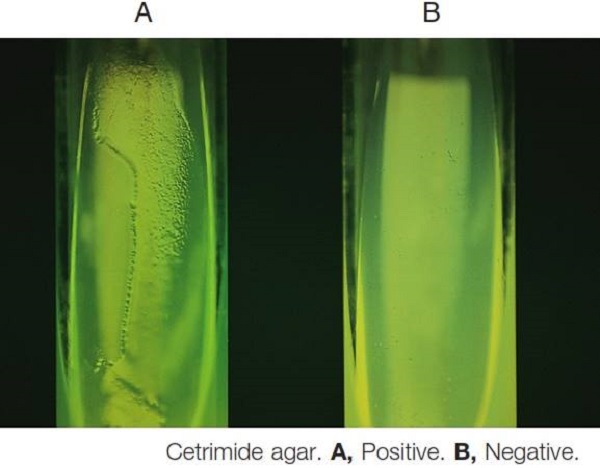Cetrimide Test- Principle, Procedure, Result Interpretation and Limitation
Cetrimide Test- Principle, Procedure, Result Interpretation and Limitation
Cetrimide is a quaternary ammonium, cationic detergent that is toxic substance to most bacteria, except Pseudomonas aeruginosa and few other bacteria.
Principle
This test is used to determine the ability of an organism to grow in the presence of cetrimide, a toxic substance that inhibits the growth of many bacteria. When cetrimide is in contact with bacteria, nitrogen and phosphorus are released from the bacterial cell. Organisms, other than Pseudomonas aeruginosa and few other pseudomonads, are unable to withstand this germicidal activity. Growth is observed on the inoculated slant of agar medium containing cetrimide for a positive result. Magnesium chloride and potassium sulfate in the medium enhance the production of pyocyanin and pyoverdin by P. aeruginosa.
Media and Reagents used for Cetrimide Test
Following ingredients per liter of deionized water
Pancreatic digest of gelatin= 20g
K2SO4 =10g
MgCl2= 1.4g
Cetyltrimethylammonium bromide= 0.3g
Agar= 13.6g
Glycerine = 10ml
Procedure of Cetrimide Test
- Streak the cetrimide agar slant back and forth with inoculum picked from the center of well-isolated colony.
- Incubate aerobically at 35-37°C for up to 7 days.
- Observe for growth and pigment.
- If no pigment is visible, examine growth under UV light for the presence of fluorescein.
- If negative for pigment at 24 hr., incubate additional days at 25°C in the dark to enhance pigment production.
Result interpretation of Cetrimide test
Positive: Growth seen. Optionally a yellow-green (fluorescein) to dark blue-green (pyocyanin) color may be observed.
Examples: Pseudomonas aeruginosa
Negative: No growth.
Examples: Escherichia coli
Quality control for Cetrimide test
Pseudomonas aeruginosa ATCC 27853- Growth
Escherichia coli ATCC 25922- Inhibited
Limitation of Cetrimide Test
- Growth on this medium alone is not sufficient for identification of Pseudomonas aeruginosa to the species level, since other non-glucose-fermenting species may grow.
- Lack of growth on cetrimide agar doesnot rule out an identification of Pseudomonas aeruginosa.

